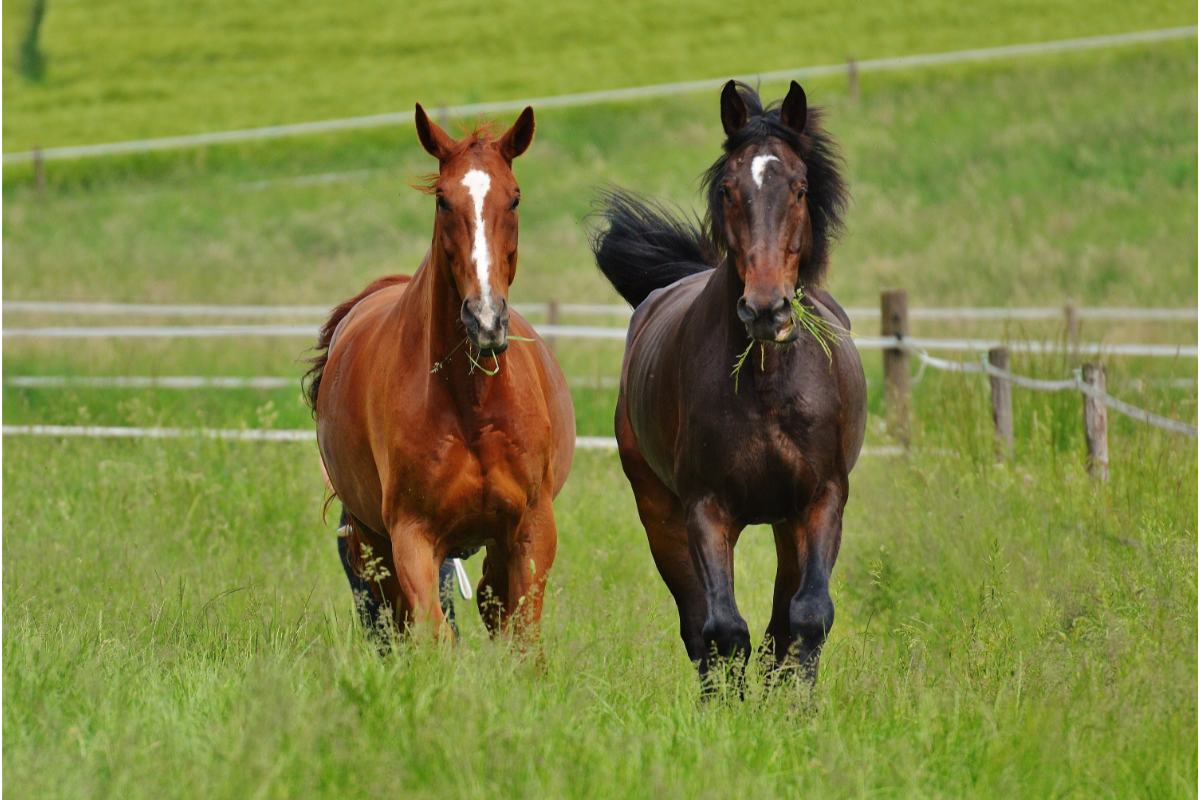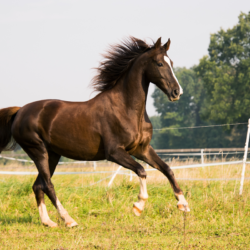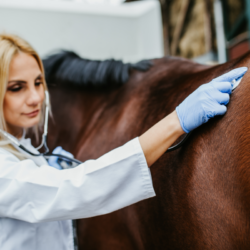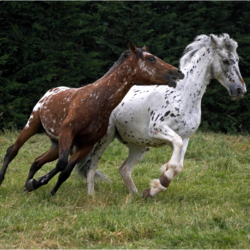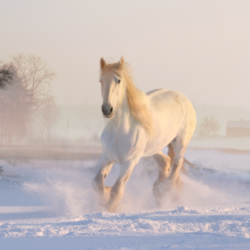Borna disease, or Borna encephalitis, is a rare but potentially fatal viral neurotropic disease affecting mainly horses and sheep. Borna virus (BoDV-1) causes severe inflammation of the brain and spinal cord. Infected horses manifest a variety of neurological symptoms that are often confused with other equine diseases, complicating diagnosis.
What causes this disease?
Borna disease occurs sporadically, particularly in southern Germany, and mainly affects horses. This enveloped, negative, single-stranded, non-segmented RNA virus has long been known, but its prevalence, transmission mechanisms and impact on health remain poorly understood. Unlike most RNA viruses, the BoDV genome is exceptionally stable over time and across different animal species.
BoDV is characterised by pronounced neurotropism, non-cytolytic replication and persistence in the central nervous system (CNS). It can also replicate in the peripheral nervous system, blood cells, thymus and bone marrow. First reported in horses and sheep in 1895, Borna disease can also affect other species, including ruminants, domestic and wild carnivores, and even primates.
The bicoloured shrew (Crocidura leucodon) serves as the main reservoir for BoDV. The virus replicates in many of this animal’s tissues and is excreted in saliva, urine, skin, tears and faeces, without causing any apparent symptoms. Although the disease is mainly found in Central Europe, infections also occur in North America, Japan, Iran and Israel. However, the exact geographical distribution of the disease remains uncertain.
What are the symptoms of Borna disease?
In horses, a small proportion of infected animals show clinical signs. The incubation period is variable, ranging from two weeks to three months. The initial phase of the disease is characterised by non-specific signs such as hyperthermia, anorexia, colic and constipation.
During the acute phase, neurological signs vary and include abnormal postures (crossed limbs), proprioceptive deficits, repetitive movements, teeth grinding, circling, stiff neck, nystagmus (involuntary rhythmic oscillation of the eyes), strabismus and miosis (pupil contraction). These symptoms are often accompanied by abnormal reactions to external stimuli, such as hyperexcitability,aggressiveness, lethargy, drowsiness or stupor.
In the final phase, paralysis may occur, followed by convulsions often associated with “wall-pushing” movements due to increased cerebrospinal fluid pressure caused by inflammation. This phase may also manifest itself as decubitus (lying down) with pedalling and convulsions preceding death. Clinical illness generally lasts from one to three weeks, with mortality rates reaching 80-100%.
Some animals survive the acute phase and develop a chronic form of the disease a few weeks later. These animals may experience recurrent episodes of depression, apathy, drowsiness and fearful behaviour throughout their lives. Horses infected with low levels of BoDV may develop chronic behavioural disorders. Veterinarians can isolate the infectious virus from a horse in the chronic phase of the disease.
How is the disease diagnosed?
Diagnosis of Borna disease is based on several methods, each with its own limitations. No single method is sufficient to establish a definitive diagnosis.
Clinical diagnosis is based on the observation of a variety of non-specific clinical signs. Serological diagnosis involves testing for antibodies in blood and/or cerebrospinal fluid (CSF) using techniques such as Western blot, ELISA or indirect immunofluorescence (IFI). However, antibody levels are often very low, especially in sub-acute or chronic cases.
Histopathological diagnosis can reveal varying degrees of encephalitis and specific BoDV inclusions in neurons. The sensitivity of this technique can be improved by immunohistochemistry, which enables major BoDV antigens to be visualised using monoclonal or polyclonal antibodies.
Viral isolation can be used for virological diagnosis, although this method is inconclusive due to the low number of infectious particles produced. Nested RT-PCR is a more reliable technique, enabling detection of the BoDV genome by increasing both specificity and amplification rate when searching for fragments of genetic material.
What treatments are available?
No specific treatment or prophylaxis (preventive measures) is currently available for Borna disease. Preliminary studies into a possible vaccination are underway. Prevention of infection by vaccination appears to be the preferred approach, rather than treatment after infection has become established. However, neither vaccination with inactivated virus nor passive transfer of humoral immunity has shown promising results in rats.
Researchers have conducted treatment trials with various molecules. Amantadine showed some efficacy in vitro and in vivo in a human psychiatric patient, but other teams have not confirmed these results. In Germany, vets sometimes administer this treatment to horses suffering from acute Borna’s disease, although its efficacy is not recognised.
Other antiviral molecules, such as ribavirin, can act on the envelope glycoprotein of the virus or interfere with its replication, but they are generally highly toxic in humans. A DNA polymerase inhibitor, AraC (Arabinofuranosylcytosine), has shown promising results in inhibiting virus replication in vitro and preventing persistent infection in rats.
Cerebrospinal fluid filtration could help to reduce the soluble and cellular components present in the CNS. Although its actual effectiveness remains to be determined, this method has been applied in humans to patients suffering from Guillain-Barré syndrome and a case of schizophrenia considered to be a sub-clinical form of Borna’s disease.
What are the natural alternatives?
The lack of in-depth research limits the natural alternatives for managing Borna disease. However, certain approaches can be envisaged to boost animals’ immune systems and help them fight the infection.
The use of medicinal plants with antiviral and immunostimulant properties can be beneficial.Echinacea, for example, is known to stimulate the immune system and may help reduce the severity of viral infections. Similarly, garlic has antiviral and antimicrobial properties that could offer some protection against BoDV.
Food supplements rich in vitamins and minerals, such as vitamin C, vitamin E and zinc, can also boost the immune system and improve resistance to infection. Regular administration of probiotics may also promote healthy intestinal flora, essential for a robust immune system.
Essential oils with antiviral properties, such as tea tree oil or ravintsara oil, can be diffused in stables to reduce the environmental viral load. However, use essential oils with care to avoid any toxicity to animals.
What are the means of prevention?
Prevention of Borna disease is mainly based on rigorous hygiene measures and reducing risk factors. Although transmission from animals to humans is controversial, it is important to take precautions to minimise the risk of infection.
Ensure that stables and grazing areas are clean and well ventilated. Avoid direct contact with sick animals or animals showing symptoms of the disease. Quarantining new animals before introducing them into a herd can help prevent the spread of the virus.
Regular monitoring of animal health and consulting a vet in the event of suspicious symptoms are crucial. Regular screening using serological or PCR methods can help to detect asymptomatic infections and take appropriate action.
Avoid stressing animals by ensuring that their environment and diet are properly managed. Stress can weaken the immune system and make animals more susceptible to viral infections.
Although studies are underway to develop an effective BoDV vaccination, there is currently no validated prophylaxis. Continued research in this area is essential to improve prevention and treatment strategies for Borna disease.

